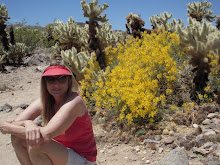 When I started visiting Joshua Tree National Park in 1989, besides the rock formations and forests of Joshua trees, there was another predictable sight. Driving on the park road through Queen Valley near the turn-off for Desert Queen Ranch, we'd see a coyote lurking at the side of the road.
When I started visiting Joshua Tree National Park in 1989, besides the rock formations and forests of Joshua trees, there was another predictable sight. Driving on the park road through Queen Valley near the turn-off for Desert Queen Ranch, we'd see a coyote lurking at the side of the road.Drivers would slow down. Some stopped and fed the coyote bits of sandwich or snacks, even though many signs around the park asked them not to. Feeding coyotes creates generations of canine beggars. Wild animals get easily conditioned to human food. They become lazy and may condition their young to beg, too. Year after year, one coyote or another hung around that stretch of road.
Over the last several years, happily, the coyote has been absent. Either gone off to greener pastures during the recent drought or relocated by park officials to a more remote area. Though it was fun to see a coyote up close and snap pictures, I'm glad he or she is gone!

No comments:
Post a Comment